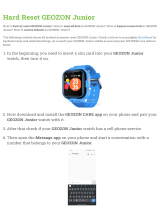
SECTION
4:
Servicing
the
Transmission
JUNIOR,
PONY
&
ECONO-HORSE
TECHNICAL
MANUAL
Page
4-6
5/90
Inspection
These instructions describe how to
inspect vital parts on the input pinion
gear and shaft assembly.
In
addition
to inspecting the parts you have
removed, you should also inspect
any replacement parts you will use.
NOTE: Thoroughly degrease and
clean all parts before inspection.
Input Pinion
Gear-
Make sure the
gear teeth are
in
good condition. If
they are broken or excessively worn,
discard the gear.
Input Pinion
Shatt-
•
If
the shaft
is
scored around the oil
seal area, discard the shaft. If the
shaft
is
pitted around the oil seal
area, you may be able to relocate the
oil seal to a smooth area. If the shaft
is
slightly corroded around the oil
seal area, try using a #400 grit emery
cloth to clean the area.
• The two snap ring grooves should
be just wide enough to fit the snap
rings.
If
the grooves have expanded,
discard the shaft. Also, examine the
edges of the snap ring grooves.
If
either the forward-facing edge on the
front snap ring groove or the rear-
facing edge on the rear snap ring
groove are rounded off do not reuse
the shaft. These are the edges that
bear the force of the snap ring.
o Keyway - The keyway should be
just wide enough to fit the key. If the
keyway has expanded, discard the
shaft.
o Threads at Front of Shaft - Check
the threads at the front of the shaft.
If
the threads are not
in
good condition,
replace the shaft.
Bushing - If the bushing is cracked,
discard
it.
Installation
Refer to Figure 4-4 as a reference for
part locations
in
these instructions.
1.
Install the input pinion gear (16)
on
the input pinion shaft (14). The shaft
and gear have flat spots that you
must line up before installing the
gear on the shaft.
2.
Install the snap ring (15) that
retains the input pinion gear to the
shaft. The rounded side of the snap
ring should face to the front of the
transmission. Although not easy to
observe, the snap ring as a rounded
side and a flat side.
3.
Install a washer (12)
on
the front
of the shaft.
4.
Install the bushing (13) on the
shaft, making sure that the groove
in
the bushing
is
facing forward.
5.
Install the second washer (12).
6.
Install the snap ring (11) that
retains the bushing and washers.
7.
Install the assembled gear and
shaft into the transmission housing.
8.
Apply a drop of removable thread
locking compound on the set screw
(17). Slowly install the screw, check-
ing to make sure the screw fits inside
the groove
on
the bushing.
Tap
the
end of the shaft with a mallet to help
seat the screw and then tighten the
screw (do not tighten the screw so
much that you damage the bushing).
9.
Apply a layer of non-hardening
gasket sealer around the outside
edge of a new oil seal (10) and install
the seal.
10. Install the two washers (9).
11
. Install the key (7 or
8)
in
the key-
way of the input pinion shaft.
12. For the Econo-Horse and older
model Junior and Pony tillers, install
the transmission pulley
(3
or
5),
disc
spring washer (2), and bolt (1).
Securely tighten the bolt.
13. For newer model Junior and
Pony tillers, install the transmission
pulley
(tl), large washer
(6).
disc
spring washer (2), and bolt
(1)
Securely tighten the
bolt
Wheel Shaft
Assembly
These instructions describe how to
service the wheel shaft assembly.
Use Figure 4-5 as a reference for
part locations in these instructions.
Removal
1.
Drain the transmission gear oil.
2.
Remove the clevis pins that hold
the wheels on the wheel shaft. Then
remove the wheels.
NOTE:
If the wheels are rusted to the
shaft and you have a wheel puller,
try
to pull the left wheel off (the left side
of the wheel shaft must pass through
the housing in order to remove the
wheel shaft).
If
you cannot pull the
left wheel off, you will have to saw it
off. After sawing the wheel shaft, use
a file to smooth off the end of the
shaft to ensure that it will pass
smoothly through the worm gear
clutch.
3.
For the Junior model only, remove
the snap ring retainer (1) from
the left
side of the wheel shaft.
II)',
,
4.
Remove the oil seal (2) ffom the
left side of the wheel shaft.
5.
Remove and discard the snap ring
(3) from the left side of the wheel
shaft.
6.
Remove the shim
(4)
from the left
side of the wheel shaft.
7.
Remove the transmission housing
cover
(see
instructions at beginning
of this section).
8.
Using a soft mallet. tap the wheel
shaft
(7)
to
the right until
it
comes
out
You
may feel resistance from the
oil seal
on
the right side of the shaft.
NOTE: The key
(6)
on
the wheel
shaft will force the right side bushing
(5)
out
along with the oil seal (2),
snap ring
(3)
and shim (4). On the
Junior model.
it
will also force out
the
snap ring (1).






















